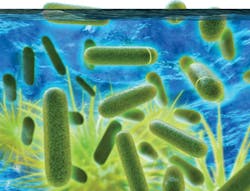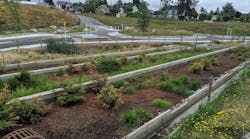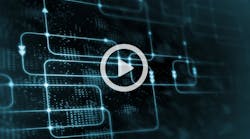In an effort to improve in-stream water quality and reduce impairments due to pathogens, EA Engineering, Science, and Technology Inc. (EA) has been performing baseline bacterial source tracking (BST) to monitor the impact of sanitary sewer overflows on surface water quality. During this time, EA has characterized long-term water quality trends in pathogen indicators from human versus non-human sources associated with improvements made to sewer collection systems. These efforts will directly benefit the Chesapeake Bay, because the sewer basins are all part of the bay watershed. Such programs will benefit the Chesapeake Bay’s $3.39 billion fishing and shellfish industry and provide improvements in public health, water quality, and nature-based recreation.
BST efforts such as this provide sustainable benefits to the economy and the community at large. According to EPA’s Microbial Source Tracking Guide, pathogens are the number one cause of surface water impairments nationally (13%), followed by metals, nutrients, and sediments. In Maryland, bacteriological impairments rank second (at 15.5%) behind “biological” categories of impairments, which may require a total maximum daily load. As a result of this regulatory interest, the need for analytical techniques that can reliably differentiate between human and non-human bacterial contributions has become quite significant. Evaluating improvements in water quality that can be attributed to sewer repair, replacement, and rehabilitation provides sustainable benefits to the Chesapeake Bay watershed, reduces costs to utilities, and can be applied to other locations across the United States.
EA also performed an extensive literature review of available technologies and conducted interviews with regional BST experts. Over the past decade, there have been substantial advances in identifying the sources of bacterial pollution to surface waters, and many of these advances have focused on determining the human contribution relative to the variety of other sources of coliform bacteria. What has been learned in Maryland can also be used across the US; therefore, enlightening other jurisdictions to EA’s finding is the purpose of this article. The goals of this article are to inform the reader of the following:
- general types of BST methods, and comparison of the advantages and disadvantages of several of these methodologies
- value of adopting BST techniques in an effort to focus system improvements in a way that reduces costs by placing an emphasis on the right source(s) of bacteria (i.e., human versus non-human)
- recent advances in BST technology, with list of reading sources to study this topic in greater detail
The next section provides a review of the current state-of-the-art BST methodologies for differentiating between human and non-human sources. The reader can use this information to help decide which BST methodologies are most appropriate for developing a water quality–monitoring plan, or to address other objectives related to watershed impairments due to bacteria. The advantages and disadvantages of each BST methodology are summarized in the “Summary of BST Methodologies” table.
Although the basic concepts of BST are not overly complex, microbial physiology, genetics, ecology, and analytical methodologies are quite complex. Determining the sources of the bacterial pollution requires linking particular bacterial characteristics to their animal host. (This host specificity is not absolute, and the outcomes are actually much less clear. For example, instead of saying bacterial Subtype A can be assigned solely to Host 5, the answers are more typically that Subtypes A, B, and D are more frequently found in Host 1, while Subtypes E, G, and R are more often found in Host 2 (Harwood 2002).)
Because of this, most BST study designs are fairly similar:
- The group of host animals that could contribute fecal material to the watershed is identified (e.g., humans, domestic animals, livestock, wildlife).
- Samples from individual host animals of each species are collected.
- Isolates obtained from these samples are subtyped using selected BST method(s).
- From these samples, a “library” of the subtyped isolates is generated.
- The patterns (fingerprints) of new isolates are statistically compared to the source library data to determine the source(s) of the bacteria within the collected samples.
Methods to Consider
BST refers to a group of rapidly emerging technologies designed to help determine the sources of fecal bacteria in environmental samples (e.g., is the source human, livestock, or some type of wildlife?). There are currently three broad categories of BST methodologies:
1. Molecular methods (genotype or “deoxyribonucleic acid [DNA] fingerprinting”)
2. Biochemical methods (phenotype)
3. Chemical methods
Molecular BST Methods (Genotype Methods)
Molecular techniques can be divided into two groups:
- Those that use restriction endonucleases (e.g., ribotyping and pulsed field gel electrophoresis [PFGE] typing)
- Those that use polymerase chain reaction (PCR) to amplify DNA
For both approaches, the DNA must first be carefully extracted, purified, and quantified. Each of these approaches is discussed as follows.
- Ribotyping.Ribotyping characterizes a specific portion of the bacteria’s DNA (Hyer and Moyer 2003). After electrophoresis and other critical sample preparation techniques, the sample preparations are exposed to X-ray films so that the hybridized regions appear as dark bands on the radiograph. The resulting banding pattern for the unknown sample (called the “ribotype” for that sample) is then statistically compared to banding patterns that have been developed for known samples within the known-source library. If the banding pattern for the unknown sample visually matches an isolate in the known-source library, then identification can be made (e.g., human, geese).
Ribotyping has good promise to discriminate among host animal species at one location (Hartel et al. 2002). However, when the isolates are from different locations, there can be large variations in the genetic fingerprint. This finding also suggests that comparisons to a known-source library from a different region could yield incorrect conclusions.
- PFGE. The PFGE technique was pioneered as a BST technology by Dr. George Simmons at Virginia Tech in the mid-1990s (Simmons et al. 2000). Modifications incorporated by the PFGE method set it apart from other electrophoresis approaches. A specially designed gel setup, called the Genepath apparatus, sends electric current through a gel in different directions for several hours, yielding superior band separation. Embedding the DNA in the agarose plugs essentially eliminates the potential for sample contamination, a common problem with other molecular BST approaches.
PFGE is a database-dependent methodology, similar to ribotyping, where researchers employ the technique to subtype isolates of water and bacterial sources by matching them with patterns from previously identified isolates stored in a known-source library. Because sources of bacterial contamination may vary from place to place, PFGE also requires isolate libraries specific to each sampling region.
- PCR Techniques. PCR is a technique that can “amplify” a specific bacterial DNA segment by producing hundreds of exact copies of a particular segment making detection easier. The method produces large amounts of specific DNA from a complex DNA template in a single enzymatic reaction within a matter of hours. The resulting strain-specific DNA is then analyzed with pattern recognition software to differentiate between closely related strains of a bacterial species. The Box primer set (Box-PCR) is one such example: It is highly reproducible, but can amplify errors. The Box-PCR method also requires a geographic-specific source library.
Biochemical BST Methods (Phenotype Methods)
Most of the next methods described offer certain advantages over molecular methods. The advantages include less required training for laboratory personnel, lower per-isolate cost (in time and materials), and the potential to perform the methods on hundreds of isolates per week (versus a few dozen isolates per week for molecular methods). The last point is notable, because sampling sites that are highly contaminated may require performing BST on several hundred isolates so that the results will be representative of the fecal population within a water body.
Microbial “libraries” are another type of reference collection that includes known sources of bacteria that have been analyzed using specific BST techniques (e.g., antibiotic resistance analysis [ARA] and carbon utilization profile [CUP]). Microbiological laboratories calculate a statistical confidence from these libraries to better define their recovery of bacteria from unknown sources. As was the case for the molecular methods discussed earlier, analysis of samples should refer to libraries that are developed from the same watershed, or be at least representative (e.g., proportionate land uses) of the sources found in that watershed (Wiggins et al. 2003).
The text below discusses two prominent biochemical methods used in BST: ARA and CUP.
- ARA. This method exposes bacteria to concentrations of various antibiotics and determines their sources (i.e., human, domestic animal, or wildlife) based on how strongly they resist specific antibiotics. ARA is a good technique for identifying bacteria from human and non-human sources. However, if the watershed is not small and has many influences (e.g., point-source and nonpoint-source contributions), the ability of the ARA method to accurately determine bacterial sources may be reduced (Simpson et al. 2002).
- CUP. Samples result in a characteristic pattern that constitutes a “metabolic fingerprint” of the strain. Resulting analytical patterns are compared to the library of known sources and given a best match. CUP can be performed in an automated fashion; however, the consistency of the results can be questionable.
Chemical Methods. Chemical methods do not detect bacteria. Instead, they measure chemical compounds that are believed to co-occur with wastewater discharges. Therefore, if these compound(s) are found in a water body, there is likely a human source with a reasonable probability that sewage pollution is also present. Three noteworthy methods are discussed below.
- Optical Brighteners. Fluorescent whitening agents are added to most laundry detergents and can be easily measured using a properly calibrated fluorometer (Hagedorn et al. 2003).
- Caffeine. Caffeine is the most commonly used drug in the world, being found in coffee, teas, chocolate, bottled soft drinks, and many over-the-counter drugs. The presence of caffeine in surface waters can be detected with proven laboratory methods.
- Fecal Bacteria Ratios. This method uses fecal coliform and fecal streptococci ratios (FC:FS) as indicators of bacteria for differentiating human versus non-human sources. It is relatively easy to use; however, it involves a number of factors than can make it difficult to interpret the results.
In summary, chemical methods potentially offer several advantages in identifying areas where human sewage may be present (e.g., cost, no library needed, proven analytical methods), but are limited because they do not directly measure pathogen concentrations. Also, there are no known correlations between a measured chemical concentration and other key pathogen attributes (e.g., bacterial in-stream survival, fate, and persistence).
Please Click Here for a summary of the BST Methodologies
Newer, Promising Molecular Methods. Over the last few years, BST has evolved from culture- based, library-dependent methods to library-independent, host genetic marker methods that do not require cultivation of the target organism. Two such methods that may be suitable for BST monitoring programs include Bacteroides 16S rRNA gene and quantitative polymerase chain reaction (Q-PCR). They are discussed in greater detail below.
- Bacteroides 16S rRNA Gene–Species of Bacteroides are host-specific, are a presence/absence methodology, and do not survive long outside of the host. This means that, when detected, their spatial and temporal origins (i.e., when and from where they were discharged) can be better estimated. Therefore, Bacteroides has been gaining increasing popularity among BST researchers as an alternative fecal indicator to E. coli and Enterococcus. The goal of the Bacteroides-based methodologies is to target specific genetic markers present in the specific host animal. Over the last several years, assays have been developed for the Bacteroides 16S rRNA gene that is specific to humans, birds, and many domestic animals. Source-specific tests are currently under development for types of wildlife.
- Q-PCR Techniques–Q-PCR follows the general principle of PCR, but includes the addition of a fluorescent marker that allows the amplified DNA or RNA to be detected in real time as the reaction progresses. Many BST researchers also consider real-time PCR to be a presence/absence methodology. However, the real-time aspect means that the presence is immediately known and follow-up tracking efforts can be performed to better find the source of the detected bacteria.
Conclusions
BST has received increasing attention in recent years as state and local authorities focus on the relative sources of pathogens in surface waters and the benefits of determining contamination from human sources versus other less controllable animal sources. Some of this scrutiny is the result of EPA’s total maximum daily load program, which requires that states identify impaired waters, and then implement approaches to bring those waters into compliance with applicable water-quality standards (EPA 2005a).
As noted by many researchers, the number of BST methods has increased substantially over the last 10 years, and the rate appears to be increasing as new methods are developed, older methods are found to be inaccurate, substantive refinements to existing methods are published, new instrumentation and software are developed, and existing methods are modified for application to different bacterial species. This review of BST methods has yielded the following conclusions:
- No “single best method” has emerged, and there is no single method that has EPA or other regulatory approval.
- There are published methods that, when properly applied, can reasonably determine if fecal bacteria are from human versus non-human (animal) sources. However, even the best methods do not approach 100% accuracy. Further separation of the animal sources to identify them as domestic animals, livestock, wildlife, geese, etc., is currently less reliable.
- The use of library-dependent methods (ribotyping, PFGE, PCR, and ARA) requires host-origin libraries that are geographically and perhaps temporally specific. The development of a host-origin library for a service area can require thousands of PCR isolates and ARA isolates and can be quite expensive to develop. In addition, the library must be tested each year by the analysis of known source isolates. However, the additional cost for testing and updating the library is small if a good host-origin library is developed during the initial project stages.
- In recent years, library-independent BST methodologies have sufficiently evolved to the point where they warrant serious consideration for BST monitoring programs. Most promising is the Bacteroides 16S rRNA gene bioassay, which is a library-independent and non-culture test. It has proven to be a more reliable indicator than library-dependent methods, and has shorter turnaround times than culture-based methods. However, it can cost significantly more.
For those who wish to change from one to another BST methodology, we recommend a gradual transition, with the replacement method being conducted concurrently on all samples for at least one monitoring year. This allows a statistical relationship to be developed between results of both methodologies.
Next Steps
In addition to the innovative technologies evaluated by EA, we will be investigating the emerging technology of canine scent tracking, which has been recently endorsed by the Water Environment Federation as a low-cost solution for prioritizing sampling sites for confirmatory DNA-based laboratory methods. EA hopes to report on this new technology in the not-so-distant future.
Selected References
Hagedorn C., R. B. Reneau, M. Saluta, and A. Chapman. 2003. Impact of Onsite Wastewater Systems on Water Quality in Coastal Regions. Progress report for Virginia’s Coastal Resources Management Program. 22 pp.
Hartel, P. G., J. D. Summer, J. L. Hill, J. V. Collins, J. A. Entry, and W. I. Segars. 2002. “Geographic Variability of Escherichia coli Ribotypes from Animals in Idaho and Georgia.” Journal of Environmental Quality 31(4), 1273–78.
Harwood, V. J. 2002. Lessons learned and questions unanswered from 5 years of bacterial source tracking. Southern California Coastal Water Research Project Authority. Microbiological Source Tracking Workshop. Presented in cooperation with EPA, State Water Quality Control Board, and the National Water Research Institute. Accessed on February 5–7 from www.sccwrp.org.
Hyer, K. E., and D. L. Moyer. 2003. Sources and Patterns of Fecal Coliform Bacteria in Three Streams in Virginia, 1999–2000; US Geological Survey, Reston, Virginia. p. 89.
Simmons, G. M., D. F. Waye, S. Herbein, S. Myers, and E. Walker. 2000. Estimating nonpoint fecal coliform sources in Northern Virginia’s Four Mile Run watershed, p. 248–67. In T. Younos and J. Poff (ed.), Proceedings of the Virginia Water Research Symposium 2000, VWRRC Special Report SR-19-2000, Blacksburg.
Simpson, J. M., J. Santo Domingo, and D. J. Reasoner. 2002. “Microbial Source Tracking: State of the Science.” Environmental Science and Technology 36(24):5279–5388.
US Environmental Protection Agency (EPA). 2005a. Overview of Current Total Maximum Daily Load–Total Maximum Daily Load–Program and Regulations. http://water.epa.gov/lawsregs/lawsguidance/cwa/tmdl/overview.cfm.
US Environmental Protection Agency (EPA). 2005b. Microbial Source Tracking Guide Document. Office of Research and Development, Cincinnati, Ohio. EPA 600-R-05-064. 150 pp.
Wiggins, B. A., P. W. Cash, W. S. Creamer, S. E. Dart, P. P. Garcia, T. M. Gerecke, J. Han, B. L. Henry, K. B. Hoover, E. L. Johnson, K. C. Jones, J. G. McCarthy, J. A. McDonough, S. A. Mercer, M. J. Noto, H. Park, M. S. Phillips, S. M. Purner, B. M. Smith, E. N. Stevens, and A. K. Varner. 2003. “Use of Antibiotic Resistance Analysis for Representativeness Testing of Multi-Watershed Libraries.” Applied and Environmental Microbiology 69(6):3399–3405.
Acknowledgement
A credible BST researcher currently utilizing the Bacteroides 16S rRNA gene methodology is Dr. Charles Hagedorn (Virginia Tech) who has been conducting the BST and total Enterococcus analysis for the Washington Suburban Sanitary Commission since the beginning of the program in 2006. We would like to acknowledge his expertise, for those who wish to learn more about the details.


